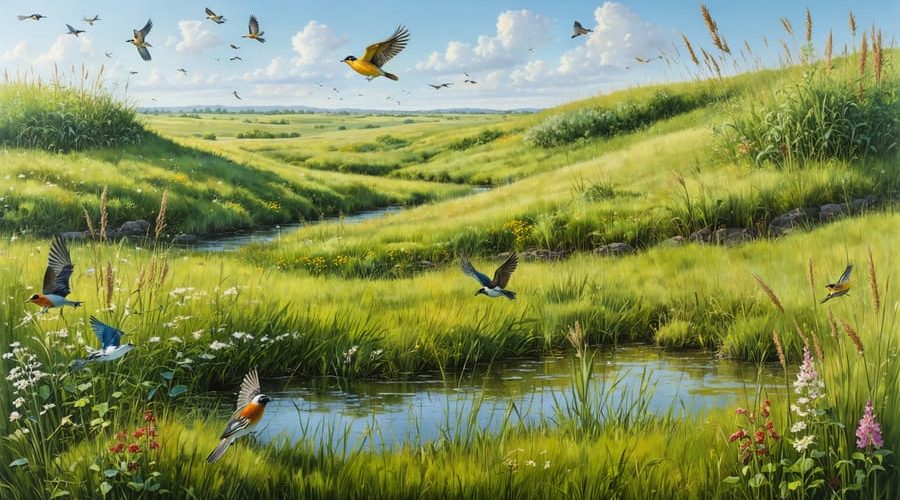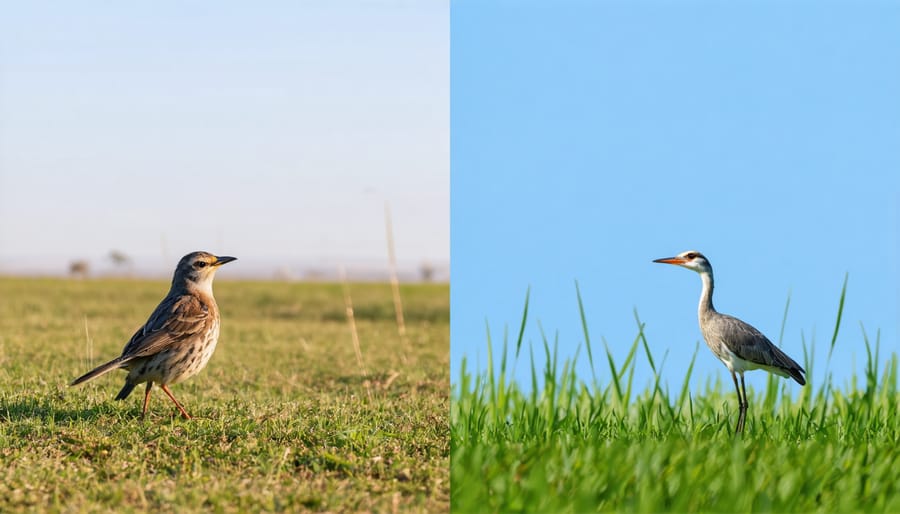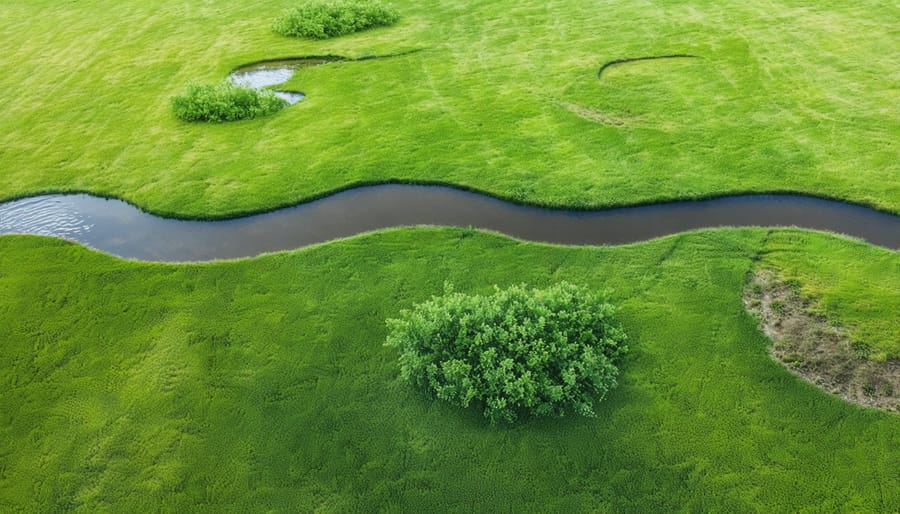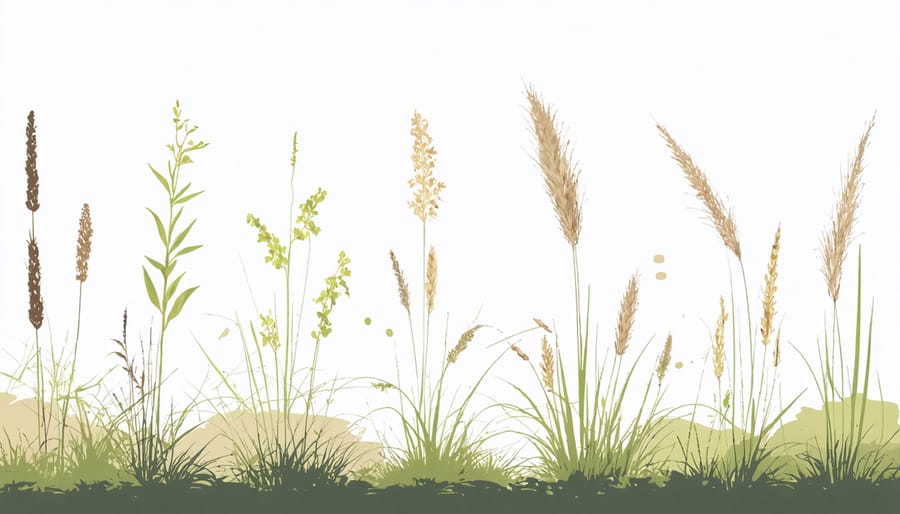
Transform Your Land Into a Thriving Haven for Grassland Birds
Transform degraded grasslands into thriving bird habitats by reintroducing native grass species like big bluestem, indiangrass, and switchgrass. These deep-rooted prairie plants create essential nesting sites while naturally controlling erosion and improving soil health. Successful restoration begins with a thorough site assessment – identifying existing vegetation, soil conditions, and local wildlife patterns helps determine the most effective restoration approach.
Native grasslands once covered nearly half of North America, supporting incredible biodiversity and serving as critical habitat for countless bird species. Today, with less than 10% of original prairie remaining, every restored acre makes a vital difference. By combining strategic planting, controlled burns, and targeted invasive species management, property owners can recreate these vital ecosystems.
The rewards of grassland restoration extend far beyond wildlife habitat. Restored prairies require minimal maintenance, naturally filter groundwater, prevent soil loss, and create stunning seasonal displays of wildflowers. Whether you’re working with a small backyard or managing hundreds of acres, restoring native grassland delivers lasting environmental benefits while creating a beautiful, sustainable landscape that supports local bird populations for generations to come.
Why Grassland Birds Need Our Help

Common Grassland Birds in North America
Several iconic bird species depend on healthy grasslands for their survival. The Eastern Meadowlark, known for its bright yellow breast and melodious song, needs tall grasses for nesting and foraging. Bobolinks, with their unique black and white breeding plumage, thrive in mixed-height grasslands where they can find both cover and open areas for displaying.
The charismatic Northern Bobwhite prefers a mix of native grasses and forbs with scattered shrubby areas. These quail need bare ground patches for dust bathing and moving around, along with dense cover for protection. Grasshopper Sparrows, though small and secretive, play a vital role in grassland ecosystems. They require short to medium-height grasses with some bare ground for catching insects.
The stately Upland Sandpiper needs large open areas with varying grass heights. They use shorter grass for feeding and taller vegetation for nesting. Each of these species benefits from different management practices, from prescribed burns to rotational grazing, highlighting the importance of diverse grassland structures in restoration projects.
The Water Connection
Water plays a vital role in successful grassland restoration, serving as a natural magnet for diverse wildlife. Adding water features like small ponds, rain gardens, or shallow wetland areas creates microhabitats that complement your grassland environment perfectly. These water sources provide essential drinking and bathing spots for birds while attracting beneficial insects that help pollinate native grasses and flowers.
Consider incorporating a gentle slope around water features to mimic natural prairie streams. This creates transition zones where moisture-loving plants can thrive alongside traditional grassland species. Even a simple birdbath can make a difference, though larger features like wildlife ponds offer more ecological benefits.
The key is to maintain shallow edges around water features, which allows safe access for ground-dwelling birds and small animals. Native sedges and rushes planted along these margins help stabilize soil and provide additional cover. During dry spells, these water features become crucial survival resources for local wildlife, making your restored grassland an even more valuable ecosystem.
Remember to position water features where they’ll catch natural rainfall and runoff, working with your land’s natural contours to create sustainable water sources that require minimal maintenance.
Planning Your Grassland Restoration Project
Site Assessment
Before diving into grassland restoration, it’s essential to thoroughly assess your site’s current conditions and potential. Start by walking your property during different times of the day to observe sunlight patterns, as most grassland plants need full sun to thrive. Take note of existing vegetation, including both native and invasive species, as this will help determine the level of site preparation needed.
Pay special attention to your soil conditions. Collect soil samples from various areas and have them tested to determine pH levels and nutrient content. Most native grassland species prefer well-draining soil, so check drainage patterns after rainfall. Look for wet spots or areas where water tends to pool, as these might need additional preparation or specific plant selections.
Consider your property’s topography and how it might affect erosion and water flow. Steep slopes may require different restoration techniques than flat areas. Also, evaluate how your restored grassland could create wildlife corridors connecting to neighboring natural areas.
Document existing wildlife activity and note any natural features like rock outcrops or water sources that could be incorporated into your restoration plan. Finally, check local regulations and zoning requirements that might affect your restoration project, including any restrictions on prescribed burns or vegetation height limits.
Integration with Water Features
Water features play a vital role in creating successful grassland habitats, serving as essential resources for both plants and wildlife. When planning your restoration project, strategically placed ponds and water gardens can transform your grassland into one of the most diverse wildlife habitats in your local area.
Start by selecting natural-looking locations for your water features, such as low-lying areas where water naturally collects. Create varying depths within your pond, including shallow edges that allow safe access for wildlife and deeper sections (at least 2 feet) to support aquatic plants and provide refuge during extreme weather.
Choose native aquatic plants that complement your grassland species, such as rushes and sedges for the pond edges, and floating plants like water lilies for the deeper sections. These plants help maintain water quality and provide additional habitat structure.
Consider installing small cascades or gentle water movement to prevent stagnation while maintaining a natural appearance. However, avoid aggressive water features that might disturb wildlife or create an artificial atmosphere.
Remember to maintain gradual slopes around your water features to prevent erosion and create natural transitions between your grassland and aquatic zones. This approach not only looks more natural but also makes it easier for animals to access the water safely.

Native Plants for Grassland Bird Habitat
Essential Grass Species
Several grass species play a vital role in supporting grassland birds, and choosing the right mix is crucial for successful restoration. Just as with native plant selection around water features, selecting the appropriate grasses creates essential habitat structure.
Big bluestem stands tall as a cornerstone species, reaching heights of 6-8 feet and providing excellent nesting cover for ground-dwelling birds. Little bluestem, its shorter cousin, offers dense coverage that’s perfect for smaller grassland birds and creates wonderful winter shelter.
Switchgrass is another must-have, forming sturdy clumps that withstand harsh weather while offering seeds that many birds love. Indian grass adds beautiful golden hues to your restoration project while supporting diverse bird species with its seed heads and protective cover.
For lower-growing areas, consider buffalo grass and side-oats grama. These species create an intricate matrix of ground cover that’s ideal for foraging birds. Prairie dropseed works wonderfully in transition zones, its fine-textured foliage creating perfect hiding spots for grassland songbirds.
Remember to include a mix of heights and densities to accommodate different bird species’ needs throughout the seasons.

Supporting Flora
When restoring grasslands for birds, incorporating the right mix of supporting plants creates a more vibrant and sustainable habitat. Native grasses like little bluestem and switchgrass form the backbone of your restoration project, but adding complementary flora enhances the ecosystem’s value tremendously.
Consider including flowering plants like purple coneflower, black-eyed susan, and goldenrod, which attract insects that birds feed on. These plants also provide essential seeds during fall and winter months. Prairie clover and native sunflowers are particularly valuable, offering both nectar for pollinators and seeds for birds.
Don’t overlook the importance of native legumes such as partridge pea and wild indigo. These plants naturally fix nitrogen in the soil, improving growing conditions for other species while providing cover for ground-nesting birds. Including different plant heights creates vertical diversity, giving birds more options for nesting and perching.
For added habitat value, incorporate patches of native shrubs like American plum or elderberry along the grassland edges. These create transition zones that many bird species use for shelter and nesting. Remember to choose plants that are native to your region, as these will be best adapted to local conditions and most beneficial to native bird species.
Maintenance and Long-term Success
Seasonal Management Tasks
Successful grassland restoration requires attention throughout the year, with each season bringing its own set of essential tasks. In spring, begin by assessing winter damage and removing any debris. Early spring is ideal for soil testing and applying necessary amendments before the growing season kicks into high gear. This is also the perfect time to overseed bare patches and introduce native wildflower species.
Summer maintenance focuses on controlling invasive plants through selective mowing or hand-pulling. Water newly established areas during dry spells, but avoid overwatering established sections to encourage deep root growth. Monitor for pest issues and address them using environmentally friendly methods.
Fall is crucial for seed collection from mature native plants, which can be used for future restoration projects. Perform any final mowing before winter, leaving grass height at about 6-8 inches to provide winter wildlife cover. This is also the time to plan controlled burns for the following spring if they’re part of your management strategy.
Winter is for planning and documentation. Review your restoration progress, update management plans, and maintain equipment. Take photographs to track changes and success rates. While active maintenance decreases, continue monitoring for damage from winter wildlife and weather events.
Remember to adjust these tasks based on your specific climate zone and local conditions. Keep detailed records of your activities and results to help refine your approach over time.
Monitoring Bird Activity
Monitoring bird activity is one of the most rewarding ways to measure biodiversity success in your restored grassland. Start by keeping a simple bird journal where you record species sightings, nesting activities, and feeding behaviors. The best times for observation are early morning and late afternoon when birds are most active.
Consider setting up a few well-placed bird feeders and water sources near observation points, which can help attract various species while making them easier to spot and identify. Take regular photos or videos to document changes over time – this visual record can be incredibly satisfying as you watch your grassland come to life!
Use a basic bird identification app or field guide to help you recognize different species. Pay special attention to grassland-specific birds like meadowlarks, sparrows, and finches, as their presence indicates a healthy habitat. Make note of seasonal patterns, including which birds are year-round residents and which are migratory visitors.
Don’t forget to listen! Bird calls are just as important as visual sightings. Recording the different songs and calls you hear can help track species that might be shy or harder to spot. As your grassland matures, you should notice an increase in both the number of species and the frequency of visits – a clear sign your restoration efforts are paying off!
Restoring grasslands is a rewarding journey that benefits both wildlife and our environment. As we’ve explored throughout this guide, successful restoration requires careful planning, the right plant selection, and ongoing maintenance. Whether you’re working with a small backyard plot or managing several acres, every restoration project makes a difference in preserving these vital ecosystems.
Remember that patience is key – grassland restoration is a gradual process that unfolds over several seasons. Start small if you’re new to restoration, and expand your project as you gain confidence and experience. The satisfaction of watching native grasses take root, seeing wildflowers bloom, and welcoming birds and butterflies to your restored habitat makes every effort worthwhile.
Ready to begin your own grassland restoration project? Start by assessing your site, gathering native seeds, and preparing your soil. Don’t be afraid to reach out to local conservation groups or extension offices for guidance. With dedication and care, you’ll be contributing to the preservation of these precious ecosystems while creating a beautiful, sustainable landscape that future generations can enjoy.
